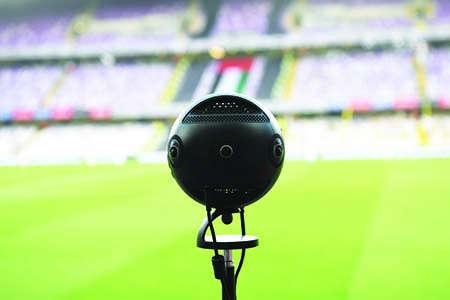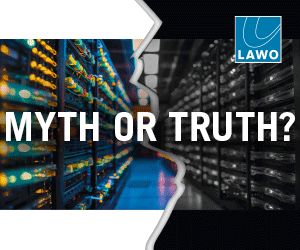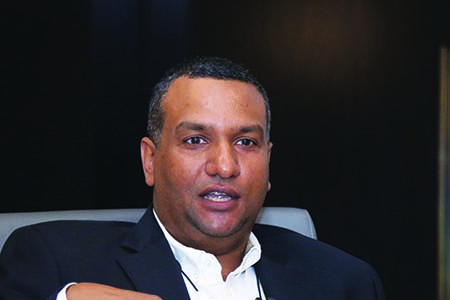– Through a dedicated 600Mbps pipe, video feeds from camera rigs of up to five cameras were transported and stitched into a single 360-degree video in real time and distributed to viewers with near indiscernible latency. BroadcastPro ME gets a ringside view of VR history on March 29 in Al Ain, scripted by the UAE […]

Through a dedicated 600Mbps pipe, video feeds from camera rigs of up to five cameras were transported and stitched into a single 360-degree video in real time and distributed to viewers with near indiscernible latency. BroadcastPro ME gets a ringside view of VR history on March 29 in Al Ain, scripted by the UAE Pro League Committee, Mediapro and Etisalat.
- Also read: Broadcasting the Arabian Gulf Cup final
- Also read: In conversation with Humaid Sahoo, CEO, E-vision
t
t
 As Mourad Batna, a striker for Abu Dhabis Al Wahda club, beat five Dubai’s Al Wasl defenders and headed the winning goal past keeper Humaid Abdulla Ali, the 180-degree VR camera behind the goal captured the ball hurtling into the back of the net. Viewers of the worlds first live VR telecast of a football league competition to a mass audience, could then shift the view to midfield, as a 360-degree camera captured the celebrations on the Al Wahda players’ bench.
As Mourad Batna, a striker for Abu Dhabis Al Wahda club, beat five Dubai’s Al Wasl defenders and headed the winning goal past keeper Humaid Abdulla Ali, the 180-degree VR camera behind the goal captured the ball hurtling into the back of the net. Viewers of the worlds first live VR telecast of a football league competition to a mass audience, could then shift the view to midfield, as a 360-degree camera captured the celebrations on the Al Wahda players’ bench.
Along with a free mobile app, this priceless moment of audience engagement cost these viewers anywhere between $5 and $100 for suitable VR gear. VR is not new, but a live VR telecast of a football match is. And distribution on a mass scale is most definitely historic.
The worlds first live VR telecast on a continous, weekly basis of a football competition, which premiered at the final of the UAE Arabian Gulf Cup at Hazza bin Zayed Stadium in Al Ain, was achieved by Spanish broadcaster and producer Mediapro, UAE telco Etisalat and, most importantly, the UAE Pro League Committee (PLC), which oversees the football competitions in the UAE.
On March 29, 2018, viewers who had downloaded Etisalat’s AGL VR Seat Experience app for both Android and IOS platforms found themselves on virtual VIP seats soaking in the excitement of the match even though they were in actual fact seated in their homes anywhere in the world.
This was not a project for the faint-hearted.
Video feeds from camera rigs of up to five cameras had to be stitched into a single 360-degree video in real time and transported back to the viewer with unnoticeable latency.

Ammar Hina, TV Broadcast and Production Director at PLC, recalls: We at PLC launched our strategy two seasons ago. Part of this strategy was to work more intensively on technology to redefine the audience experience of live football. The idea for broadcasting in VR also came two seasons ago.
Two seasons ago roughly translates to August 2016. Hinas team at PLC reached out to broadcast solutions provider Mediapro Middle East, which was already providing equipment and crew to LIVE HD, PLCs official broadcast partner since 2007.
Mario Bayarri, CEO of Mediapro Middle East, recounts: We did the first VR pilot with Samsung during the Clásico (match between FC Barcelona and Real Madrid) two years ago. It was limited to providing the feed to 100 people. Samsung invited their clients to Madrid and the match was being played in Barcelona, and the invited viewers experienced it as if they were in the stadium.
Bayarri says the project was part of the companys commitment to the creation of virtual reality content, an investment driven by the companys division dedicated to museum and exhibition space and video game content development. However, the journey from a limited pilot project to a live project with the UAEs PLC on a mass level wasnt straightforward. The challenge, surprisingly, wasnt the VR technology.
Bayarri explains: The problem today is not about having the right camera or recording footage in VR. The problem is to make sure you are able to provide what you are producing to the audience in real time. We needed to standardise the solution to be able to stream it live and deliver on a large scale.
A team was constituted in August 2017 to design the workflow. Mediapro partnered with VR specialist Visyon to use the latters Vroadcaster platform to do real-time stitching and live streaming of the matches. Visyon also developed the app that Etisalat offers subscribers.
One of the biggest roadblocks for live streaming is bandwidth, and for VR with multiple camera rigs and points of view, the up requirement has to be multiplied by the number of rigs. This translates to very high bandwidth requirement. Etisalat, a long-time partner of PLC, offered dedicated bandwidth of a minimum of 600Mbps.
Speaking at the launch of the VR app, Humaid Sahoo, CEO of E-Vision, the broadcasting arm of Etisalat, said: We are delighted to partner with the Pro League Committee to unveil the regions first virtual reality app to broadcast live football matches, enabling our consumers to experience the thrill of the games from the comfort of their homes.
 Elaborating on the connectivity to the CDN in Barcelona, Jordi Alonso, Area Digital Head of XR (Virtual Reality/Augmented Reality/Mixed Reality) for Mediapro, says: We use single-mode fibre optics from the cameras to the control centre at the stadium, and from there, we rely on guaranteed bandwidth reserved by Etisalat to reach our cloud transcoding platform on the way out. All workflow is 4K. Tier1 CDN is used for the final delivery, with live transcoding. At this moment, the service is given to Samsung GearVR, Cardboard Android, Cardboard iOS and to web browsers through a WebGL app.
Elaborating on the connectivity to the CDN in Barcelona, Jordi Alonso, Area Digital Head of XR (Virtual Reality/Augmented Reality/Mixed Reality) for Mediapro, says: We use single-mode fibre optics from the cameras to the control centre at the stadium, and from there, we rely on guaranteed bandwidth reserved by Etisalat to reach our cloud transcoding platform on the way out. All workflow is 4K. Tier1 CDN is used for the final delivery, with live transcoding. At this moment, the service is given to Samsung GearVR, Cardboard Android, Cardboard iOS and to web browsers through a WebGL app.
The roadblocks for the live VR telecast were not very different from those a traditional broadcaster faces, reveals Bayarri.
You have the local issues arising from changing the stadium every day, so typical questions are about where to position the camera and cables, do I need to patch and so on. Of course, with VR you have to make sure that all the positions have the same light and the same configuration, and sometimes you have to hide a pole, because this is not an imaginative VR experience. This is real, as if you were seated in the stadium.
Ammar Hina gives this writer a tour of the busy OB vans parked outside Hazza bin Zayed Stadium. In one of the smallest and least imposing of them, we meet Jose Maria Caro, Director of Content, Head of Production and Services Mediapro Middle East.
These men are making history, Caro says, indicating three men at the far end of a bare van seated in front of fairly nondescript monitors.
We have three 180-degree and two 360-degree VR cameras. Each camera has six to eight different cameras within, and we have three cameras with fisheye lens. Two 180-degree cameras are behind each goal and one 180-degree camera is in the middle of the pitch offering a full view. The two 360-degree cameras have been placed as if you are in a VIP seat with audience around you and a clear view of the pitch in front.
The app allows you to select the camera view you want to watch. We have also recorded previous matches, and those are stored on the cloud to ensure the app was content-rich even at the outset.
With live VR, you need broadband. We opted for 4K cameras because we did not want to lower the quality of the image. From monitoring the internet connection to ensuring our cameras remain safe on the field, there are all sorts of challenges.
Satellite and fibre distribution company Overon helped monitor the transportation of the feed and made sure the CDN in Barcelona was stable, adjusting the bitrates to ensure consistent feed delivery throughout the 90 minutes of the match.
As we watch Ammar Hina, Jose and their teams work to ensure the perfect VR experience, we realise how difficult it must have been to arrive at this milestone.
It is about pioneering new technology, stresses Ammar Hina. The cost factor is not as important now as it is to redefine the viewing experience though futuristic technology. The teams from Etisalat, Mediapro and we at PLC want to be at the forefront of this phenomenon.
While the love for technology unites the men we meet, there is also an undeniable passion for the game. Bayarri expresses this: I have not been able to watch matches in Barcelona since I moved to Dubai. If someone were to tell me you can sit on your couch and watch your team play, maybe even sit next to the coach or watch the goal from two metres away I would love it. I have had the opportunity to watch matches on the ground along with the TV crew, and that is a privilege for me. Through VR, we are able to let fans immerse themselves in the game like never before. But will VR go the way 3D did?
I dont think it will happen, Bayarri says emphatically. The problem with 3D, apart from lack of content, was basically the audience had to take a big step to experience 3D in their homes you needed to buy a 3D screen and in the case of VR, it is not about sitting in your home. The VR gadgets are very reasonably priced, and you could be sitting anywhere enjoying the experience. VR is a reality today not just in sports but in any type of theme parks and museums, among other places. Also, imagine VR in retail. You can watch a fashion show in Paris as if you are really there. The potential in the field of education and other sectors is endless.
Monetising is the next step. PLC will gain with an increase in its audience base, and for Etisalat, it opens up avenues in so many sectors beyond football, to stream in VR.
From the time the contract was signed in August 2017, the process has been a challenging learning curve for everyone concerned, Bayarri admits.
My understanding a year ago was this seems easy to do. Now I see it is quite complicated to execute. But I also see tremendous potential. This is just the first step. We will soon move into 3D VR, mixed reality and so on. I see so many possibilities. The hardest aspect for us now is to determine the next step, because there are so many different paths we could take.
Beyond this landmark VR experiment, Bayarri spells out the next move.
While we know how many people downloaded the app and how much time they used it, we need to now understand what they value in the experience. Did they watch all 90 minutes, or just replays of goals, or did they watch catch-up TV after the match? We need to understand better how the consumer is experiencing the match.
Broadcasting the Arabian Gulf Cup final
 Ammar Hina, TV Broadcast and Production Director at the UAE Pro League Committee (PLC), gives Broadcastpro ME a guided tour of Hazza bin Zayed Stadium in Al Ain. We tour the OB vans at the OB compound outside the stadium, including those of the rights holders Abu Dhabi and Dubai Sports Channels, as well as the OB van for the host broadcaster LIVE HD, and walk by camera positions in the stadium as vociferous fans of Al Wahda and Al Wasl warm up for kick-off.
Ammar Hina, TV Broadcast and Production Director at the UAE Pro League Committee (PLC), gives Broadcastpro ME a guided tour of Hazza bin Zayed Stadium in Al Ain. We tour the OB vans at the OB compound outside the stadium, including those of the rights holders Abu Dhabi and Dubai Sports Channels, as well as the OB van for the host broadcaster LIVE HD, and walk by camera positions in the stadium as vociferous fans of Al Wahda and Al Wasl warm up for kick-off.
On the innovations for the marquee event, Hina says: Other than the historic debut of VR, we are also deploying the video assistant referee (VAR) system for the first time in the MENA region, along with the tracking and heatmap system. For the match, we also have a sky camera and a drone to capture the arrival of the teams by bus, among other moments. In terms of the broadcast solutions deployed, the set-up here adheres to the best standards in the world.
Explaining the scale of production, Hina explains: We have 21 cameras. Two of them are used to collect rushes around the stadium, including behind-the-scenes footage of players’ dressing rooms, and this is made part of the main feed. We have 19 live cameras, plus two of them are super slow-motion cameras. Since it is the cup final, it is one of the biggest events organised by PLC. And ensuring the highest on-air quality increased viewership which reached about nine million views last season, more than double the viewership for the season before.We are then able to sell sponsorship for the current as well as coming seasons.
In 2016, PLC contracted LIVE HD as its exclusive production company for the Arabian Gulf League, Arabian Gulf Cup and Arabian Gulf Super Cup for the next three years.
Commenting on the challenges of running the broadcast operations, Hina says:
We dont have the same quality of connectivity in stadiums everywhere, so it is difficult to have a fixed production plan. As PLC, we work with many clubs and venues. The challenge is to maintain broadcast standards even in older stadiums.
This stadium in Al Ain has advanced patching facilities. We dont run any cables. It was awarded the best stadium in the world in 2014. “
At the end of every match, we have a full technical report from the production company as to which patch is not working. Every couple of weeks, we have a long sheet we share with clubs with items to rectify in their respective stadiums.
For such a critical event, we begin preparations at least three months in advance. And when the final whistle blows, we breathe a sigh of relief.
In conversation with Humaid Sahoo, CEO, E-vision

How did the initiative with PLC and Mediapro come about for the VR app for live football?
Mediapro was commissioned by the PLC to build and develop the VR application and to deliver the live broadcast in VR. The process for this began back in Q2 of 2017 where the initial planning was discussed and the technical feasibility assessed to determine if the project could be launched.
What was Etisalats role in the process?
As the official sponsor of the Arabian Gulf League (AGL) and the first VR experience worldwide for a live match, Etisalat worked closely with Mediapro to co-develop the Etisalat VR application. We were also heavily involved in supplying the connectivity needed to support the broadcast in relation to setting up dedicated high bandwidth IP links to the stadium and supplying the routers needed by Mediapro in order to use and broadcast the live game.
What were the challenges in achieving the first live VR telecast on March 29?
As this had never been done in the region and as it was a first, there were many challenges that we faced from gaining access to the stadiums to doing the required testing, to ensuring that we were receiving the required feeds from servers in Frankfurt. We had to arrange the fibre connectivity to the stadium in a very short time and there were many teams from both Etisalat and Mediapro who dedicated many hours to run weekly testing at the stadiums to ensure the stability and constant quality of the feeds needed were there for an effective live broadcast. We had a very short time-frame to test and ensure the Quality of Service for the game.
Going forward, what is the potential for telcos such as Etisalat with such initiatives?
The opportunity is huge when you consider that you now have a VR app that allows you to broadcast live events to a mass audience. Such value-added services allow us to give our customers new experiences and bundle the VR app with their existing postpaid mobile service or offer pay-as-you-go access to live events. More importantly it provides a new revenue stream where you can offer subscription-based offers or day passes to consumers to watch particular sporting, cinema and concert events live from the comfort of their home in VR













































































